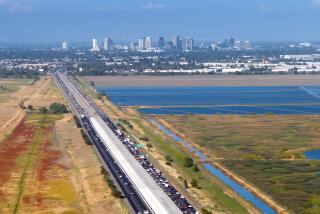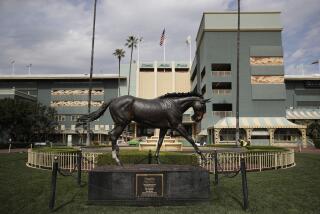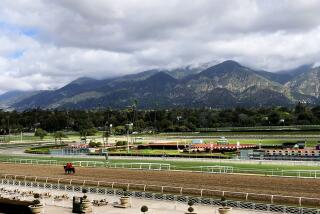Fair Board Plan Has Blind Spot
- Share via
Most anyone who has attended the Del Mar Fair or the thoroughbred races in recent years would be sympathetic to the Fair Board’s desire to increase parking and ease traffic jams.
Fair attendance has grown along with the county’s population, and it’s reasonable to believe that trend will continue. More than 80,000 people went to the fair one day this past summer, and that peak attendance is projected to increase to 92,000 by the year 2000.
To accommodate the inevitable increase in cars, the Fair Board has repeatedly tried to obtain land along the San Dieguito River to use as overflow parking for about 12 of the fair’s busiest days. The board’s latest attempt was vetoed by state public works officials. But the board’s recent draft public works plan still lists river valley property as potential seasonal parking. Between fairs, the land would be planted with grass and left vacant.
In addition, the fair board is proposing to build a seasonal off-ramp from northbound Interstate 5 just south of the Via de la Valle exit. The new exit would be open only during the three-month fair and racing season.
Those solutions make sense if the needs of fair-goers and racing fans are considered apart from other regional concerns. But they should not be, even though the fairgrounds are run by a state, rather than a local, agency.
Just as fairground events serve the whole county, so too, should fairground policies and plans.
This is particularly true regarding the fledgling San Dieguito River Valley Regional Open Space Park. The river runs alongside the fairgrounds, and park planners are justifiably concerned about the damage that building a freeway ramp would inflict on wetlands. Fair officials say the ramp plans would affect no more than an acre of wetlands and that other wetland areas would be restored to make up for the damage.
Park planners are also concerned that prime potential parkland not be used for overflow parking as is suggested in the fair board’s proposal.
We agree.
The park and the fairgrounds each have a role in serving the recreational needs of San Diegans. And they have to coexist in an imperfect world, where the need to accommodate cars confounds even the most dedicated planners. With creative planning and compromise, perhaps they can find ways to complement each other.
But, where their goals conflict, the park, the San Dieguito Lagoon and wetlands should come first.
As the fair board has learned through experimentation in recent years, there are alternatives to parking at or near the fairgrounds. The fair board has leased parking spaces at UC San Diego, Torrey Pines High School, MiraCosta College and Eastgate Mall, using shuttles to transport as many as 8% of fair-goers. But the leases are short-term, and the unpredictability of that off-site parking, combined with the predictability of increased fair attendance propels fair officials to find parking sites near the fairgrounds.
Their concern is understandable. But the environmentally sensitive coastal location of the fairgrounds dictates finding other remedies. The planned San Diego-to-Oceanside commuter train should be taken into greater account in fair board plans, and a renewed effort by both fair and park officials should be made to find long-term remote parking sites.
This is a time for policies that encourage alternative transportation systems, not a time for building facilities that encourage traditional automobile travel.
More to Read
Go beyond the scoreboard
Get the latest on L.A.'s teams in the daily Sports Report newsletter.
You may occasionally receive promotional content from the Los Angeles Times.










